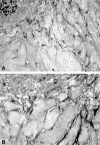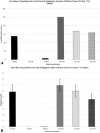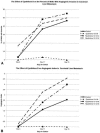Development of a novel in vitro human tissue-based angiogenesis assay to evaluate the effect of antiangiogenic drugs
- PMID: 12796575
- PMCID: PMC1514676
- DOI: 10.1097/01.SLA.0000072111.53797.44
Development of a novel in vitro human tissue-based angiogenesis assay to evaluate the effect of antiangiogenic drugs
Abstract
Objective: To describe a novel in vitro human tissue-based angiogenic model that can predict an individual tumor's response to antiangiogenic drugs.
Summary background data: A number of in vitro and in vivo angiogenesis assays exist, but they do not provide potentially useful information for the treatment of an individual patient. Clonogenic assays have been used to evaluate the response of an individual's tumor to antineoplastic agents, but these tumor fragments are cultured in an environment that does not lead to neovessel growth. The authors have previously demonstrated that human vein disks or human tumor xenograft fragments incorporated into a 0.3% fibrin-thrombin clot will develop angiogenic vessel growth from the cut edge of the vessel disk or xenograft fragment.
Methods: Fresh human tumor or normal tissue disks (2 x 1 mm) from fresh surgical specimens were incorporated into fibrin-thrombin clots overlain with nutrient medium containing either 20% fetal bovine serum alone or in combination with Epothilone B, a tubulin inhibitor with antiangiogenic properties. Tissue disks were visually assessed over time to determine the percentage of wells that developed an angiogenic response. Neovessel growth, density, and length were graded at intervals using a semiquantitative visual neovessel growth-rating scheme (angiogenic index, 0-16 scale) devised in the authors' laboratory.
Results: Epothilone B treatment at doses of 10-6 mol/L and 10-8 mol/L decreased the number of wells that developed an invasive angiogenic response and limited the development of vessels that invaded the matrix. At these doses, Epothilone B also caused regression of vessels in wells that had been allowed to develop an angiogenic response. Treatment of tumors or normal tissues with Epothilone B at doses less than 10-8 mol/L was ineffective.
Conclusions: Epothilone B may be an effective antiangiogenic agent in a variety of tumor types. The authors speculate that this in vitro model might provide useful information to the clinician on the effect of specific antiangiogenic agents on individual tumors. This may be particularly useful in patients with tumors that, as a group, are unresponsive to treatment with antineoplastic agents.
Figures




Similar articles
-
Metronomic dosing enhances the anti-angiogenic effect of epothilone B.J Surg Res. 2011 Aug;169(2):247-56. doi: 10.1016/j.jss.2009.12.001. Epub 2009 Dec 30. J Surg Res. 2011. PMID: 20338584 Free PMC article.
-
A novel assay to assess the effectiveness of antiangiogenic drugs in human breast cancer.Ann Surg Oncol. 2008 Dec;15(12):3407-14. doi: 10.1245/s10434-008-0145-2. Epub 2008 Sep 16. Ann Surg Oncol. 2008. PMID: 18795370
-
A new in vitro assay for human tumor angiogenesis: three-dimensional human tumor angiogenesis assay.Ann Surg Oncol. 2004 Jan;11(1):99-104. doi: 10.1007/BF02524353. Ann Surg Oncol. 2004. PMID: 14699041
-
Synopsis of angiogenesis inhibitors in oncology.Oncology (Williston Park). 2002 May;16(5 Suppl 4):14-22. Oncology (Williston Park). 2002. PMID: 12102576 Review.
-
Approaches to preclinical screening of antiangiogenic agents.Semin Oncol. 2001 Dec;28(6):570-6. doi: 10.1016/s0093-7754(01)90026-0. Semin Oncol. 2001. PMID: 11740811 Review.
Cited by
-
Randomised phase II trial of weekly ixabepilone ± biweekly bevacizumab for platinum-resistant or refractory ovarian/fallopian tube/primary peritoneal cancer.Br J Cancer. 2022 Jun;126(12):1695-1703. doi: 10.1038/s41416-022-01717-6. Epub 2022 Feb 11. Br J Cancer. 2022. PMID: 35149854 Free PMC article. Clinical Trial.
-
A study of pipeline drugs in neuroendocrine tumors.J Gastrointest Cancer. 2012 Jun;43(2):296-304. doi: 10.1007/s12029-011-9286-9. J Gastrointest Cancer. 2012. PMID: 21556722
-
Surgical treatment of advanced-stage carcinoid tumors: lessons learned.Ann Surg. 2005 Jun;241(6):839-45; discussion 845-6. doi: 10.1097/01.sla.0000164073.08093.5d. Ann Surg. 2005. PMID: 15912033 Free PMC article.
-
Radiosensitizing effect of epothilone B on human epithelial cancer cells.Strahlenther Onkol. 2012 Feb;188(2):177-84. doi: 10.1007/s00066-011-0029-4. Epub 2012 Jan 12. Strahlenther Onkol. 2012. PMID: 22234539
-
Enterostatin inhibition of angiogenesis: possible role of pAMPK and vascular endothelial growth factor A (VEGF-A).Int J Obes (Lond). 2008 Jun;32(6):922-9. doi: 10.1038/ijo.2008.16. Epub 2008 Feb 26. Int J Obes (Lond). 2008. PMID: 18301390 Free PMC article.
References
-
- Hamburger AW, Salmon SE. Primary bioassay of human tumor stem cells. Science. 1977; 197: 461–463. - PubMed
-
- Kern DH, Weisenthal LM. Highly specific prediction of antineoplastic drug resistance with an in vitro assay using suprapharmacologic drug exposures. J Natl Cancer Inst. 1990; 82: 582–588. - PubMed
-
- Costa SD, Lange S, Klinga K, et al. Factors influencing the prognostic role of oestrogen and progesterone receptor levels in breast cancer: results of the analysis of 670 patients with 11 years of follow-up. Eur J Cancer. 2002; 38: 1329–1334. - PubMed
Publication types
MeSH terms
Substances
LinkOut - more resources
Full Text Sources
Other Literature Sources

